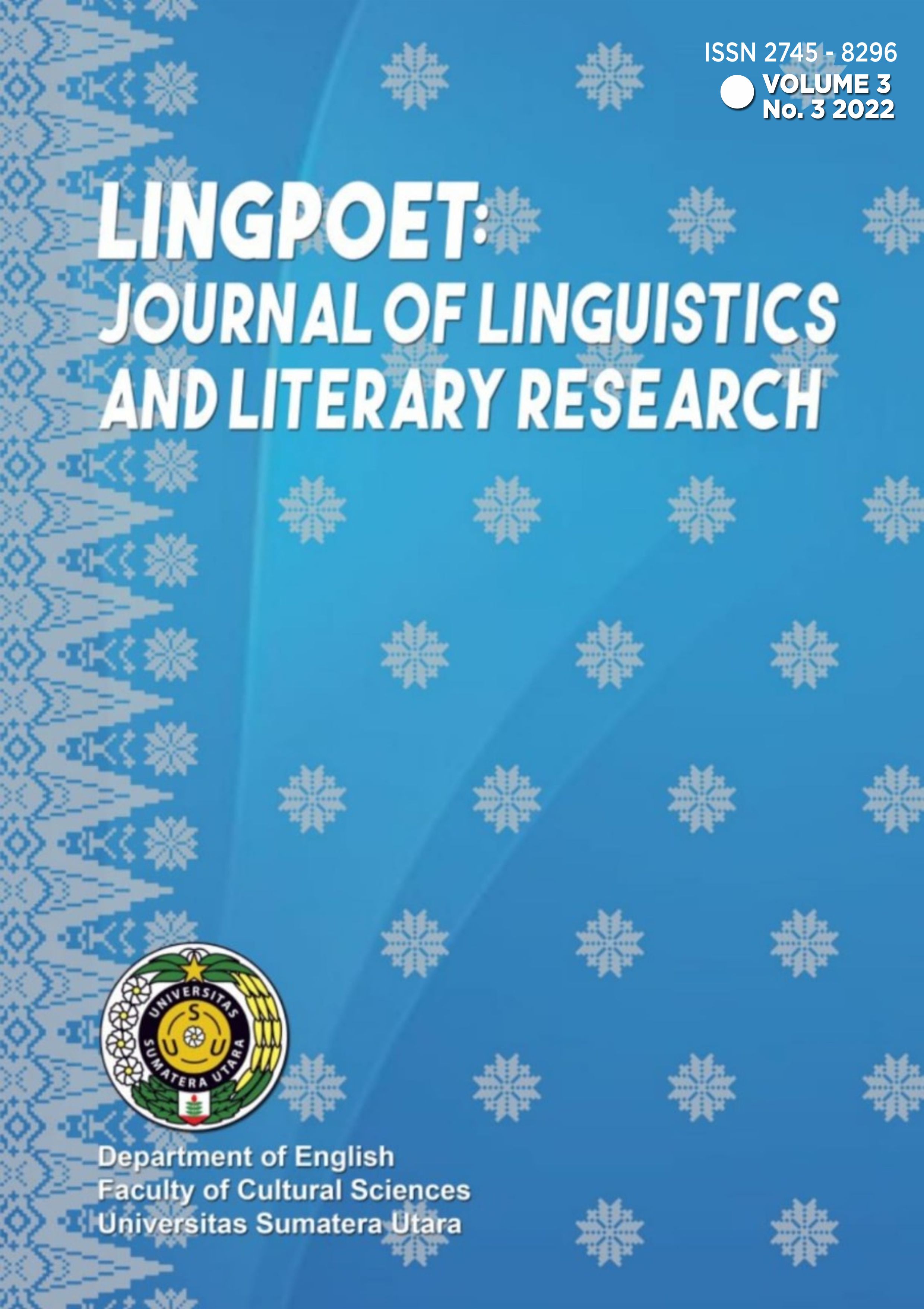Conceptual Metaphors in the Hazaragi Community’s Institution of Marriage in Balochistan, Pakistan
DOI:
https://doi.org/10.32734/lingpoet.v3i3.9302Keywords:
Balochistan, conceptual metaphor, Hazara, Hazaragi culture, marriage, PakistanAbstract
Conceptual metaphor theory explains conceptual systems through cross-domain mappings. The mapping occurs on a conceptual level in a way that one conceptual domain is understood in terms of another conceptual domain. It also shows how target domain is perceived or understood through numerous source domains. Daily life experiences of people create patterns of understanding and conceptual metaphors are used to utilise these patterns in our utterances about issues in the world. In this research paper, Lakoff and Johnson’s (1980) conceptual metaphor theory and Grice’s (1975) implicature theory are used as theoretical frameworks to identify, study and interpret conceptual metaphors for marriage in the Hazaragi community in Balochistan, Pakistan. This study focusses on the institution of marriage as this institution carries rich conceptual domains and has many conceptual mappings. Data collected from the book on Hazaragi idioms and two Hazaragi dramas were used to identify and analyse five general categories which include marriage as a food, marriage as an expensive commodity, marriage as a friendship, marriage as a slavery, and marriage as a journey or time. The paper also explores implied conceptual metaphors for marriage which do not indicate the concept of marriage directly. In short, this study discusses how conceptual metaphors in the institution of marriage depict Hazaragi culture and tradition.
Downloads
References
R. Nick J. and N. K. Albert, “Something false about conceptual metaphors,” Metaphor Symb., vol. 3, no. 1, pp. 36–47, 2018.
N. Bosman and Taljard. Elsabé, “A Cross-Linguistic Study of BLOOD Metaphors in Afrikaans and Northern Sotho,” Lang. Matters, vol. 52, no. 1, pp. 3–29, 21AD.
N. Hosokawa, “From reality to discourse: analysis of the ‘refugee’ metaphor in the Japanese news media,” J. Multicult. Discourses, vol. 16, no. 3, pp. 277–291, 2021.
C. T. Beck, “Subsequent Childbirth After a Previous Birth Trauma: A Metaphor Analysis,” Issues Ment. Health Nurs., vol. 42, no. 10, pp. 909–916, 2021.
A. R. Leo and D. Maya K., “A Critical Metaphor Analysis on Malaysia’s Gazetted Metaphors amid the Movement Control Order: A COVID-19 Episode,” J. Humanit. Soc. Sci. Res., vol. 2, pp. 193–204, 2020.
A. Bochaver and F. Anna, “Metaphors in Happy and Unhappy Life Stories of Russian Adults,” Metaphor Symb., vol. 25, no. 04, pp. 243–262, 2010.
F. Boers, “applied Linguistics Perspectives on Cross-Cultural Variation in Conceptual Metapho,” Metaphor Symb., vol. 18, no. 4, pp. 231–238.
N. A. Kharlamov, “Boundary Zone between Cultural Worlds or the Edge of the Dominant Culture? Two Conceptual Metaphors of Marginality,” Stud. J. Intercult., vol. 33, no. 6, pp. 623–638, 2012.
L. Gao, “A Comparative Study of Conceptual Metaphors in English and Chinese Economic News Headlines,” Creat. Educ., vol. 07, no. 17, pp. 2629–2639, 2016.
J. Grady, “A typology of motivation for conceptual metaphor: correlation vs. resemblance,” Metaphor Cogn. Linguist., p. 79, 1999.
J. Matusitz and O. James, “Visual Motifs in Islamist Terrorism: Applying Conceptual Metaphor Theory,” J. Appl. Secur. Res., vol. 11, no. 1, pp. 18–32.
R. Vengadasamy, “Metaphors as ideological constructs for identity in Malaysian short stories,” Southeast Asian J. Engl. Lang. Stud., vol. 17, pp. 99–107, 2015.
M. I. Amin, “Conceptual Metaphors of Love in ‘Happy New Year’—A Poem by Suad Al Sabah,” US-China Foreign Lang., vol. 15, no. 9, 2007.
K. Niebert and G. Harald, “Understanding Starts in the Mesocosm: Conceptual metaphor as a framework for external representations in science teaching,” Int. J. Sci. Educ., vol. 37, no. 5–6, pp. 171–201, 2015.
H. G. Close and S. Rachel E, “Enacting Conceptual Metaphor through Blending: Learning activities embodying the substance metaphor for energy,” Int. J. Sci. Educ., vol. 37, no. 5–6, pp. 839–866, 2015.
B. W. Dreyfus and et al, “Applying Conceptual Blending to Model Coordinated Use of Multiple Ontological Metaphors,” Int. J. Sci. Educ., vol. 37, no. 5–6, pp. 812–838, 2015.
D. Felzmann, “Using Metaphorical Models for Describing Glaciers,” Int. J. Sci. Educ., vol. 36, no. 16, pp. 2795–2824, 2014.
R. Wiseman, “Social Distance in Hunter-Gather Settlement Sites: A Conceptual Metaphor in Material Culture,” Metaphor Symb., vol. 29, no. 2, pp. 129–143, 2014.
G. N. Ansah, “Culture in Embodied Cognition: Metaphorical/Metonymic Conceptualizations ofFEARin Akan and English,” vol. 29, no. 1, pp. 44–58, 2014.
T. Ehineni, “From Conceptual Metaphors to Cultural Metaphors: Metaphorical Language in Yoruba Proverbs and Praise Poems,” Lang. Matters, vol. 48, no. 3, pp. 130–144, 2017.
A. Burgermeister-Seger, “An analysis of conceptual metaphor in marital conflict,” Portland state University. [Online]. Available: doi.org/10.15760/etd.6412
J. Kusmanto, “Exploring the cultural cognition and the conceptual metaphor of marriage in Indonesia,” LiNGUA J. Ilmu Bhs. Dan Sastra, vol. 11, no. 2, p. 63, 2016.
P. Eubanks, “The Story of Conceptual Metaphor: What Motivates Metaphoric Mappings?,” JSTOR Collect., vol. 20, no. 3, pp. 419–442, 1999.
M. H. Hazara, New Hazaragi Drama "THOI, (2018). [Online]. Available: www.youtube.com/watch?v=pALuF8PRj2o
A. Pereltsvaig, The Language of Hazara. Languages of the World, 2013. [Online]. Available: www.languagesoftheworld.info/geolinguistics/the-language-of-hazara.html
H. A. Yousafi, Farhang-e-Adbiate Hazaragi Zarbulmisal wa Mahawrat. Hazaragi Academy, 2010.
F. Gulzari, The Hazaras: A Historical, Political and Economic Account of Events Along the Silk Road. 2018.
I. Ali and B. Poladi, The Hazara tribe in Pakistan. Hazaragi Academy Quetta, 2017.
M. Azad, I am Hazara. Hazaragi Academy Quett, 2014.
“More than 3,000 Hazaras killed since Sept 11, 2011,” Dawn, 2018. [Online]. Available: www.dawn.com/news/1409576
S. Sultan and et al, “A Multi-layered Minority: Hazara Shia Women in Pakistan,” 2020, [Online]. Available: opendocs.ids.ac.uk/opendocs/handle/20.500.12413/15878
M. Azad, “I am Hazara,” Hazaragi Acad. Quetta.
H. K. Baluch, ہزارگی زبان کا فارسی سے کوئی تعلق نہیں. Independent Urdu, 2019.
C. McIntosh, “Cambridge Advanced Learner’s Dictionary.” Cambridge UP, 2013.
S. Batool, Hazargi Wedding. Dost Pakistan, 2021. [Online]. Available: www.dostpakistan.pk/hazargi-wedding/
H. Poladi, The Hazāras. Avenue Books, 1989.
G. Lakoff and J. Mark, Metaphors We Live By. U of Chicago, 1980.
G. Lakoff and M. Turner, More than Cool Reason: A Field Guide to Poetic Metaphor. U of Chicago P, 2009.
V. Evans and G. Melanie, Cognitive Linguistics: An Introduction. Routledge, 2018.
H. P. Grice, Logic and Conversation.
“Gold Rate In Pakistan Today, 4th May 2021,” Daily Times, [Islamabad], 2021. [Online]. Available: dailytimes.com.pk/751979/gold-rate-in-pakistan-today-gold-price-in-pakistan-on-4-may-2021/.
H. Bacha, Haal khatoo - 80’s Best Hazaragi Stage Drama, (2021). [Online]. Available: www.youtube.com/watch?v=hAYpY4ERsio
Z. Maalej, “Figurative Language in Anger Expressions in Tunisian Arabic: An Extended View of Embodiment,” Metaphor Symb., vol. 19, no. 1, pp. 51–57, 2004.

Published
How to Cite
Issue
Section
Copyright (c) 2022 LingPoet: Journal of Linguistics and Literary Research

This work is licensed under a Creative Commons Attribution-ShareAlike 4.0 International License.







